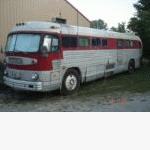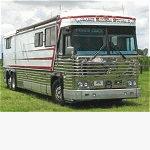| Author | Message | ||
| Bill Holstein (Billmoocow)
Registered Member Username: Billmoocow Post Number: 133 Registered: 5-2009 Posted From: 71.59.162.64  Rating: N/A |
Hey,It Is cold. Ever tried to put a boiling pot on the stove. Seriously. It works! Try it, you do not know until you try. Hot steam is a blessing. | ||
| FAST FRED (Fast_fred)
Registered Member Username: Fast_fred Post Number: 1377 Registered: 10-2006 Posted From: 66.82.9.82  Rating: N/A |
Propane releases 1.2 lbs of water vapor for every pound burned. Add uncovered water and you may need wipers inside the coach. FF | ||
| Austin Scott Davis (Zimtok)
Registered Member Username: Zimtok Post Number: 456 Registered: 9-2006 Posted From: 173.166.209.1  Rating: N/A |
The increase in temperature probably has more to do with the stove putting out heat to boil the water then the water vapor itself.... Try a humidifier and see if you get the same results. . | ||
| ED Hackenbruch (Shadowman)
Registered Member Username: Shadowman Post Number: 334 Registered: 11-2003 Posted From: 75.211.86.6 Rating: N/A |
Our house on Maui was an old plantation house. Single wall construction, no insulation of course, so when it got cold we would cook a turkey to heat the house. | ||
| Sean Welsh (Sean)
Registered Member Username: Sean Post Number: 1206 Registered: 1-2003 Posted From: 72.171.0.145  Rating: |
"Propane releases 1.2 lbs of water vapor for every pound burned." Actually, a little more than 1.6 pounds, if it really is propane. Most bottled gas we call "propane" in this country is actually LPG (Liquefied Petroleum Gas) and contains a mix of several hydrocarbons, principally propane and butane. The further south one travels, generally the higher concentration of butane; LPG in Mexico is generally mostly butane. Burning butane will generate a little less than 1.6 pounds of water for every pound of butane burned. LPG will fall between these two amounts, so 1.6 pounds is a close approximation. LPG weighs about 4.2 pounds per gallon, and water weighs about 8.34 pounds per gallon. So in gallons, there will be about 0.8 gallon of water produced for every gallon of LPG burned. This is the reason you get so much humidity when using a catalytic heater inside an RV. All of that said, it takes just 970 BTU to vaporize a pound of water once it is already at 212°F. At an approximate average of 21,400 BTUs in a pound of LPG, it will take just .045 pounds of LP to generate a pound of steam. The additional 0.07 pound of water vapor from the combustion process is almost insignificant by comparison. FWIW. -Sean http://OurOdyssey.BlogSpot.com | ||
| Jack Fids (Jack_fids)
Registered Member Username: Jack_fids Post Number: 251 Registered: 1-2009 Posted From: 69.171.161.214  Rating: N/A |
Kind of makes you wish you had installed that dry Sauna first eh Bill.... A large metal oil drain pan with a quart of Alcohol in the bottom is what I've always known as an "Oklahoma FirePlace".... Toss a match into the pan & you have instant heat (and water vapor) Just make sure you have plenty of un-burnable space around the pan! I've danced around them for almost 60 years, from the South Pole to Duluth & it's kept my butt warmer than not! . . I like Ed's Turkey idea....mmmm | ||
| Dallas Farnworth (Dallas)
Registered Member Username: Dallas Post Number: 169 Registered: 7-2004 Posted From: 98.20.57.89  Rating: N/A |
Jack, . . . What a waste of good alcohol! . . . Easier and less wasteful to just warm up by drinking it. . . . As long as it's not made in old radiators! . . . Cat and I always warm the bus on really cold mornings by cooking a large breakfast on the propane stove. . . . We use to warm it at night in other ways, but we don't live in the bus while we are remodeling! ;) | ||
| Jack Fids (Jack_fids)
Registered Member Username: Jack_fids Post Number: 252 Registered: 1-2009 Posted From: 69.171.161.214  Rating: N/A |
Sorry, I should have specified Methanol or SXL... not Ethanol, heaven forbid! (especially the kind that comes from Oak Barrels) "RE-Modeling".... Hhmmm that's a name for it that I've never run across before, you ARE creative Dallas! | ||
| ED Hackenbruch (Shadowman)
Registered Member Username: Shadowman Post Number: 336 Registered: 11-2003 Posted From: 69.97.102.126 Rating: N/A |
I forgot to mention that we had no other source of heat in that house other than the oven. Didn't need it 98% of the time. Had no ac either, just open doors and windows and ceiling fans. | ||
| Jack Fids (Jack_fids)
Registered Member Username: Jack_fids Post Number: 253 Registered: 1-2009 Posted From: 69.171.161.214  Rating: N/A |
Ain't it amazin what 2 hearts can keep warm or cool depending on the season... Sounds like my rig... windows open no/ac or heat! . . only it ain't no Hawaiian Beach Home. I get the feeling you'd be willing to throw some water & sand in my face to approximate your experience. ;) | ||
| ED Hackenbruch (Shadowman)
Registered Member Username: Shadowman Post Number: 339 Registered: 11-2003 Posted From: 69.97.102.126 Rating: N/A |
No, we didn't have a beach home. We were "Up Country" at about the 11-1200 ft. level and about 6 miles from the nearest beach. | ||
| Dave Walker (Chrome_dome)
Registered Member Username: Chrome_dome Post Number: 133 Registered: 3-2010 Posted From: 67.174.144.159  Rating: N/A |
I have a nephew who lives on Maui in a condo they bought After it was an apartment they rented. Their rent was very high for a 400 sq/ft place. They bought it after some up grade for 60K 10 years ago and now it is worth 180K. He has a whale site seers boat that he takes people out on and his wife runs 2 Sin Shops (cigarettes and Booze, that's what they call them on their business license)They don't make a lot but love it there. Dave | ||
| Teresa (Happycamperbrat)
Registered Member Username: Happycamperbrat Post Number: 71 Registered: 5-2009 Posted From: 173.25.102.158 Rating: N/A |
I dont know what the numbers equal out to, but years ago I worked in a metal building with no insulation. To keep warm I had an electric hot plate and I would boil a stew on it. Yes the windows got wet, but it was warm in there. | ||
| FAST FRED (Fast_fred)
Registered Member Username: Fast_fred Post Number: 1380 Registered: 10-2006 Posted From: 69.19.14.26  Rating: N/A |
"The further south one travels, generally the higher concentration of butane; LPG in Mexico is generally mostly butane." While it may make the walls drip water , the propane /butane mix is more efficient than the old Freon 12 as a refrigerant. FF | ||
| Bruce Henderson (Oonrahnjay)
Registered Member Username: Oonrahnjay Post Number: 637 Registered: 8-2004 Posted From: 70.60.102.56  Rating: N/A |
One thing that makes a difference for us here (coast of NC) is that we live with high humidity for 8-9 months. Then if we get a winter front that's cold enough to really be cold, the air is usually dry as old bones. What that means is that air can absorb a fair amount of water vapor and still be low enough on the % humidity scale as to not make everything wet. Of course, if the whole house had added moisture, adding moisture in particular area (shower, cooking) will make it damp in that area. But it's not so bad here as places like Florida and other Gulf Coast states where it's humid year round. (My grandfather used to keep a small kettle sitting on the three-tiled bottled gas heater in his den in the winter just to add humidity to the air in the house.) | ||
| Sean Welsh (Sean)
Registered Member Username: Sean Post Number: 1207 Registered: 1-2003 Posted From: 72.171.0.147  Rating: N/A |
Working out the numbers is pretty straightforward. Your stew is mostly water; even though meat, potatoes, veggies, etc. may have slightly different specific heats, they, too, are mostly water. So for all intents and purposes, we can use water for the calculation. Assuming you used a two-quart sauce pan and it was mostly full, you had about four pounds of water. If that water came out of a pipe in the ground it might have been about 65° when you started. It takes one BTU to raise one pound of water one degree Fahrenheit (the very definition of a BTU), so to raise the four pounds from 65° to the boiling point of 212° required 588 BTU. If you continued to add heat after it came to a boil, some of that water vaporized into steam, requiring an additional 970 BTU per pound. However, if you had vaporized even a pound, you're stew would only be 3/4 of what you started with. A more likely figure is 15% boiled off, which would be 0.6 pounds for 582 BTU. So to cook your stew took just 1,170 BTU. As a comparison, that amount of heat is produced by a 1,500-watt space heater in 14 minutes. Importantly, however, none of that heat made your building any warmer until later, when either you ate the stew, or it cooled back down to room temperature, thus losing its heat to the environment, and the steam condensed on the walls. IOTW, the heat from the hotplate going into the stew did not directly heat your building at the time. Instead, it was the waste heat from the cooking process, meaning heat that the hot plate was producing which did not increase the temperature of the stew. Some of that heat is lost directly from the hot plate and its enclosure to the atmosphere, and some of it is radiated from the pot, which is poorly insulated (if at all). If you know the size of the hot plate (in watts) and the amount of time it took to cook the stew, you could tell exactly how much waste heat went to heating the building. But here is an important point: In Thermodynamics, there is no free lunch (or stew). If you have a 1,500-watt hot plate, it can't possibly produce more heat than a 1,500-watt space heater. Boiling a pot of water is no more efficient than directly heating the air, and, in fact, it is arguably less so, because some of the heat of vaporization is lost more quickly to the environment when the steam finds its way out of the building. The OP's assertion that "hot steam is a blessing" seems to imply that creating the steam somehow heats the interior faster. In actual fact, the act of making the steam does not heat the coach at all -- it is the condensing of the steam back into water that heats the coach. While that may be somewhat faster than, say, heating a steel plate on the same stove top, the actual amount of heat going into the coach will be the same. Because cooking appliances must first heat some medium, whether that's a gallon of water, a hunk of steel, or a rump roast, and then that medium must in turn give back that heat to the environment in order to warm that environment, cooking appliances are almost never as effective at heating a space as an identically rated heating appliance. Of course, when you're cold, a hot cup of tea or, mmmmm... a nice hot bowl of stew, can be much more effective at warming you up than, say, a one- or two-degree increase in the environmental temperature. -Sean http://OurOdyssey.BlogSpot.com | ||
| R.C.Bishop (Chuckllb)
Registered Member Username: Chuckllb Post Number: 1432 Registered: 7-2006 Posted From: 97.215.83.249  Rating: N/A |
.............  RCB | ||
| les marston (Les_marston)
Registered Member Username: Les_marston Post Number: 182 Registered: 1-2010 Posted From: 68.151.225.213  Rating: N/A |
Sean I would never dispute your numbers. I have no question that you are correct but I wonder on this We had a hot rock sauna at one time. It would raise the temp in the sauna to a certain level ( i don't remember how hot) When we poured water onto the hot rocks it produced steam and the perception of a massive increase of temperature in the sauna Is this an actual increase or just the increase in humidity that made it feel much hotter and if so then could not the increase of humidity from the stew give the perception of a higher temperature? or possibly just distribute the available heat faster? Just wondering Les | ||
| Roderick W. Chandler (Rod)
Registered Member Username: Rod Post Number: 62 Registered: 11-2003 Posted From: 173.184.52.227  Rating: N/A |
When you introduce steam and increase humidity in Sauna you decrease the ability of sweat to evaporate thus cooling your body, The perception of increased heat is partially caused by this. Hotter in Louisiana than Central Texas at 100 degrees because of difference in humidity. | ||
| Sean Welsh (Sean)
Registered Member Username: Sean Post Number: 1208 Registered: 1-2003 Posted From: 72.171.0.147  Rating: N/A |
Les, OK so let me start by saying that I am not a physiologist, so I don't pretend to know all the mechanisms by which humans perceive "heat." That said, I know from my emergency preparedness background that humidity has a great deal to do with it, and, moreover, most people will recognize the term "heat index" which is used in weather reports to factor humidity into heat perception. To answer your question, there are two things going on here. One is the humidity itself. The body cools itself through the evaporation of moisture from the skin; when it needs more cooling more moisture is generated, in the form of sweat. Whether or not this process is effective depends a great deal on the relative humidity of the environment. Relative humidity is a measure of the air's ability to absorb moisture. When relative humidity is 100%, the air is "saturated" and can absorb no moisture whatsoever, and at this point the human body can not shed heat at all through the normal evaporative mechanism. Obviously, making a bunch of steam in the room by putting water on the rocks immediately raises the relative humidity (and thus "heat index) inside the room, and anyone in the room would subjectively feel "hotter" due to this effect alone. I said there were two things at work. The other is that steam gives off a great deal of heat when it condenses back into water. Specifically, 970 BTU per pound, as described above. With no humans in the room, and no additional heat input, merely putting water on the rocks will not change the overall temperature of the system. In fact, the immediate result will be to actually lower the temperature, as heat is consumed in vaporizing the water. However, any surface that the steam subsequently contacts, including yourself, will cause the steam to condense and thus give back its heat of vaporization, and so the local effect to that object will be to heat it up. This energy given off when steam condenses, BTW, is why live steam is so dangerous. An ounce of steam will do far more damage to you than an ounce of boiling-hot water. To answer your final question, yes, the additional humidity generated by either the OP's boiling water or Teresa's boiling stew will increase the heat index and thus the subjective feeling of warmth in the room. However, there is a limit to this effect, and at colder temperatures that limit is reached in fairly short order. -Sean http://OurOdyssey.BlogSpot.com | ||
| Bill Holstein (Billmoocow)
Registered Member Username: Billmoocow Post Number: 134 Registered: 5-2009 Posted From: 71.59.162.64  Rating: N/A |
To answer your final question, yes, the additional humidity generated by either the OP's boiling water or Teresa's boiling stew will increase the heat index and thus the subjective feeling of warmth in the room. I rest my case. | ||
| Dallas Farnworth (Dallas)
Registered Member Username: Dallas Post Number: 171 Registered: 7-2004 Posted From: 72.172.36.62  Rating: N/A |
OK, Riddle me this: Why does a fire in a fireplace warm you much better than the direct heat of an infrared heater? Neither has any humidity, both only heat the surface of what they are close to. But after many years of living with a wood stove, a propane furnace, an Oil furnace, even a sawdust furnace back in the 60's.... Why, oh Why does a Fireplace with a roaring fire feel so much better? | ||
| Sean Welsh (Sean)
Registered Member Username: Sean Post Number: 1209 Registered: 1-2003 Posted From: 72.171.0.147  Rating: N/A |
Bill, I don't think anyone disputed your statement. Fred's point, upon which I elaborated, is that's a lot of moisture to put into a coach, which has consequences of its own. Also, if your relative humidity is already near 50%, adding to it, while it might make one feel subjectively "warmer," would also make most people feel uncomfortable. A relative humidity of 40%-60% is usually the best compromise for human comfort and the well-being of your systems and furnishings.
Because they consume more fuel. Many firewoods have a BTU content of 6,000-7,7000 BTU per pound, and it is not uncommon for a fireplace or wood stove to consume three pounds or more per hour, for anywhere from 18,000-20,000 BTU per hour. By contrast, a 1,500-watt electric space heater (whether infrared or other radiant) produces just 5,120 BTU per hour, or less than a third the heat. For comparison a Webasto DBW-2010 can produce 40-45,000 BTU per hour, and many LP furnaces are in the 30,000 BTU/hr range. To produce the same 20,000 BTU you would get from three pounds of oak would require just a little less than one pound of LP or just a little more than one pound of diesel, making either of those a more efficient choice, by a factor of three, if you have to carry your fuel with you. FWIW. -Sean http://OurOdyssey.BlogSpot.com | ||
| Jack Conrad (Jackconrad)
Registered Member Username: Jackconrad Post Number: 1358 Registered: 12-2000 Posted From: 71.3.72.124  Rating: |
Just a reminder. Any burning fuel will produce carbon monoxide. If the burning is unvented inside a closed up bus (whether in the form of a heater or stove), carbon monoxide can build to a level that can lead to death or permanent brain injury (but you will have pretty cherry red lips). Make sure to allow proper venting and have a working carbon monoxide detector. I would hate to read about you waking up dead. Jack | ||
| Sean Welsh (Sean)
Registered Member Username: Sean Post Number: 1210 Registered: 1-2003 Posted From: 67.142.130.37  Rating: |
Actually, Jack, pure propane and butane burn cleanly with no carbon monoxide or other harmful products of combustion. These fuels, when burned properly, produce only water and carbon dioxide as combustion byproducts. That said, most fuel sources, including LPG, contain small amounts of other hydrocarbons, as well as sulfur dioxide and other compounds which can produce harmful combustion products. Also, even when the reactants are present in stoichiometric quantities, failure to completely combust can produce unwanted byproducts. So your advice is sound: make sure there is a supply of fresh air as well as a working CO detector. -Sean http://OurOdyssey.BlogSpot.com | ||
| Jim Shepherd (Rv_safetyman)
Registered Member Username: Rv_safetyman Post Number: 320 Registered: 1-2004 Posted From: 72.171.0.140 Rating: N/A |
Sean, way over my head on this subject, but doesn't the combustion of the propane and butane consume some of the oxygen in the bus? Is that not a health issue? I really think we need to be careful not to condone some units, as it leads to the general conclusion that all kinds of heaters/heating scenarios are safe. Jim Shepherd Evergreen, CO ’85 Eagle 10/Series 60/Eaton AutoShift 10 speed transmission Somewhere between a tin tent and a finished product Bus Project details: http://www.rvsafetysystems.com/busproject.htm Blog: http://rvsafetyman.blogspot.com/ | ||
| Sean Welsh (Sean)
Registered Member Username: Sean Post Number: 1211 Registered: 1-2003 Posted From: 67.142.130.42  Rating: N/A |
Yes and yes. Which is, again, why burning LP indoors, whether that's on a cooktop, in an oven, or using a catalytic-type heater, requires a supply of fresh air, and all manufacturers recommend leaving a window open. The formulae for the combustion of propane and butane under "ideal" conditions, which in chemical terms means using stoichiometric quantities of all reagents, are Propane: C3H8 + 5O2 -> 3CO2 + 4H2O Butane: 2C4H10 + 13O2 -> 8CO2 + 10H2O So as you can see, five oxygen molecules are consumed for every propane molecule, or 6.5 oxygen molecules for every butane molecule. Propane has a mass of 44.1 and oxygen a mass of 32, so for each pound of propane consumed, roughly 3.6 pounds of oxygen will be consumed. Air at sea level weighs .075 pounds per cubic foot, and is 23% oxygen by weight, so one pound of oxygen requires 58 cubic feet of air (at sea level). Therefore for each pound of propane burned you will need to supply 210 cubic feet of fresh air. The calculations for butane are nearly identical. -Sean http://OurOdyssey.BlogSpot.com | ||
| Jim Shepherd (Rv_safetyman)
Registered Member Username: Rv_safetyman Post Number: 321 Registered: 1-2004 Posted From: 72.171.0.140 Rating: N/A |
Sean, my apologies, I got in a hurry and did not read your last sentence (in your reply to Jack)and missed your comments about the oxygen supply. The first couple of sentences looked like you were saying that it was OK to use those units inside and it got me all shook up. The issue is that folks don't want to open a window since that lets cold air in. It just scares the begeebers (is that a word?) out of me when I hear about combustion inside a coach with a small volume. Now the million dollar question. If the units don't emit CO, but the oxygen supply is being depleted (window closed condition), will that trigger a CO detector?? Sounds like it might not. Jim Shepherd Evergreen, CO ’85 Eagle 10/Series 60/Eaton AutoShift 10 speed transmission Somewhere between a tin tent and a finished product Bus Project details: http://www.rvsafetysystems.com/busproject.htm Blog: http://rvsafetyman.blogspot.com/ | ||
| Sean Welsh (Sean)
Registered Member Username: Sean Post Number: 1212 Registered: 1-2003 Posted From: 67.142.130.42  Rating: N/A |
Not soon enough. As you can see from the formulae above, the two products-of-combustion from burning propane and/or butane are water and carbon dioxide. Oxygen is consumed, in the ratios I outlined above. In a sealed environment, the net effect will be to gradually replace the oxygen in the atmosphere with carbon dioxide and water vapor. Carbon dioxide is, of course, not harmful in moderate quantities, but the lack of oxygen can be deadly. The carbon dioxide will not set off most CO detectors, nor will the lack of oxygen. That being said, as the oxygen in the sealed environment is depleted, it becomes impossible for the reaction to be sustained in stoichiometric balance. Ultimately the nice, sharp blue flame that indicates proper combustion will change into a yellow flame, and there will even be visible evidence of molecular carbon depositing on the burner and/or pot. At this point the reaction is no longer ideal and there will be several combustion byproducts besides the two harmless ones. One of those products will be CO as I alluded to in my earlier post when I wrote "failure to completely combust." At that point, a CO detector should alarm, however by this time in a sealed environment there would already be physiological effects from the lack of oxygen. Long-winded way of agreeing with you: I advise against using LP in a confined space for heating purposes. Even using it in limited quantities for cooking merits careful attention to ventilation. FWIW. -Sean http://OurOdyssey.BlogSpot.com | ||
| Dallas Farnworth (Dallas)
Registered Member Username: Dallas Post Number: 174 Registered: 7-2004 Posted From: 72.172.36.62  Rating: |
Most buses leak more air than the Kursk! (Message edited by Dallas on December 02, 2010) dam keyboard! (Message edited by Dallas on December 02, 2010) | ||
| Sean Welsh (Sean)
Registered Member Username: Sean Post Number: 1213 Registered: 1-2003 Posted From: 67.142.130.42  Rating: N/A |
Well, yes. But a 30,000 BTU/hr propane heater would consume 1.4 pounds of propane per hour, requiring an air supply of at least 292 cubic feet per hour of fresh air. That's nearly 5 CFM, if you want to think of it in fan terms. Many buses probably leak as much as 5 CFM with everything closed up, but not all do. -Sean http://OurOdyssey.BlogSpot.com | ||
| R.C.Bishop (Chuckllb)
Registered Member Username: Chuckllb Post Number: 1434 Registered: 7-2006 Posted From: 70.219.37.161  Rating: N/A |
Whew.....U R busy today, Sean...   RCB | ||
| Jim Shepherd (Rv_safetyman)
Registered Member Username: Rv_safetyman Post Number: 322 Registered: 1-2004 Posted From: 72.171.0.140 Rating: N/A |
When I was researching my BCM article on CO detectors, I was blown away by the impact of compromised oxygen levels in the blood. Obviously smokers have some pretty significant issues as does anyone with a lung capacity issue. I would suspect that reduced available oxygen would compromise good decision making and that condition would just spiral downwards. This whole subject of using any combustion device in a confined area is scary to me. Jim Shepherd Evergreen, CO ’85 Eagle 10/Series 60/Eaton AutoShift 10 speed transmission Somewhere between a tin tent and a finished product Bus Project details: http://www.rvsafetysystems.com/busproject.htm Blog: http://rvsafetyman.blogspot.com/ | ||
| larry currier (Larryc)
Registered Member Username: Larryc Post Number: 340 Registered: 2-2007 Posted From: 207.200.116.13 Rating: N/A |
I have used the ventless Buddy Propane heater. It will shut off if the oxygen level drops/depletes. It is very clean and if your bus is tight it will keep us warm in fairly cold weather on low. I would not use any gas heater that did not have an oxygen sensor/shut off in my bus. My Suburban Furnace is vented outside the bus on the combustion side. Both intake and exhaust. The heat side has nothing in common with the burner side. | ||
| FAST FRED (Fast_fred)
Registered Member Username: Fast_fred Post Number: 1384 Registered: 10-2006 Posted From: 66.82.9.99  Rating: |
Many buses probably leak as much as 5 CFM with everything closed up, but not all do. ON many the "leak" is built in from the factory , our '06 Sports car and most GM buses have vents built into the front door . These need to be covered heating in low temperatures , where the glass area needs to be covered usually below freezing. FF | ||
| Jack Fids (Jack_fids)
Registered Member Username: Jack_fids Post Number: 256 Registered: 1-2009 Posted From: 69.171.161.162  Rating: |
Somehow, I just KNEW you would get around to those door vents! I thought they might be for pressure equalization when the '06 goes into warp speed.... | ||
| FAST FRED (Fast_fred)
Registered Member Username: Fast_fred Post Number: 1387 Registered: 10-2006 Posted From: 69.19.14.26  Rating: N/A |
I just KNEW you would get around to those door vents! WE need extra sealing as after disposing of the stock heater I cut the inner wall of my bus and located a 40,000BTU boat (same as a bus) heater that would suck outside air from the stock holes that fed the old HVAC system. Above freezing a magazine , half open , on the heater box seals enough so the cold fresh air can be ignored. Below freezing , it gets sealed. 75mph is hardly warp speed , more like impulse power. FF | ||
| Jack Fids (Jack_fids)
Registered Member Username: Jack_fids Post Number: 277 Registered: 1-2009 Posted From: 69.171.161.173  Rating: N/A |
Now I understand! You see the PO added zeros to all the numbers on the speed-o ....I suppose this means my milage numbers are incorrect too? Man today is just not my day..... I owe you Fast. |